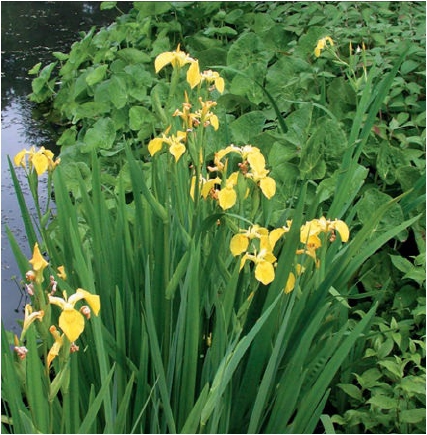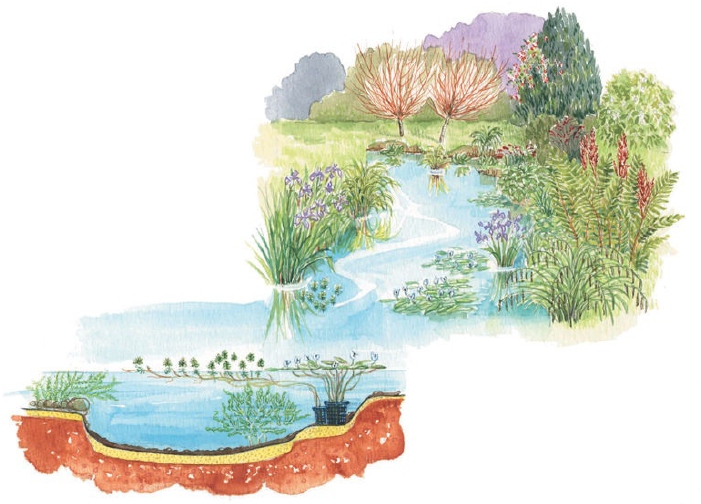Are they difficult to grow?
you will need trees, shrubs and flowers to complement the pond and to enrich the wildlife habitat, bog plants for the damp ground around the water’s edge, emergent or marginal plants for the shallows, floating or deep-water plants for a whole range of depths, and aquatic plants that may be completely or partially submerged. They are no harder to grow than any other garden plants, as long as you match them to the correct site.
Of course, you should choose plants that you like, but make sure you include ones that will oxygenate the water, as well as ones that will provide food and cover for all the wildlife in and around the pond (see also pages 10–11).
When planting the areas around the water, choose plants both for their characteristics and for the fact that they will provide a habitat for all the creatures attracted by the water.
Plants only thrive when they are growing in conditions that suit their nature, so always read the labels before setting them in position. This is especially important with water plants that are depth-specific – some water plants will die if the water is too shallow or too deep for their liking.

There are irises to suit every growing situation – from slightly moist soil through to deep water, and from sunshine to shade. Iris pseudacorus (Yellow Flag) loves wet conditions.
• Be wary, in a pond that has been made with a butyl rubber liner (see pages 20–21), of growing plants that have sharp, pointed roots – such as some species of bamboo and couch grass.
• Make sure that no single tree, bush, grass or other plant around the pond overwhelms other species.
• Do your best, when planting in and around the pond, to use species that are common in your area.
• Underplant surrounding trees and shrubs with ground-cover plants.
These are the plants that grow along the water’s edge – in the shallows of slow-flowing streams, ponds and canals, for example. Although in general terms most plants are able to withstand short alternating periods of drought and flood, for emergents or marginals the depth of water is critical. Such plants are perfect for wildlife water gardens, where you are trying to encourage small creatures to take up home.
Although there is some crossover between aquatics and floating plants (see below), the difference is that aquatics have root systems that dissolve and absorb nutrients. Some aquatics float, while others are partially or totally submerged. Aquatics clean up the water in two ways: they feed on all the ‘rubbish’ at the bottom of the pond, and they give off bubbles of oxygen. If you want high-quality water, which is good for wildlife, then you need aquatics.
These are plants that thrive in the wet soil of a bog garden and provide cover for frogs, newts, snakes, insects, mice and snails, among other creatures.
These have leaves that float on the surface of the water, and roots that either trail in the water or anchor themselves into the mud at the bottom of the pond. The floating leaves and flowers provide cover for wildlife, and hold back the growth of algae. If you want to encourage a wide range of pondlife such as small fish, snails, newts and frogs, you need floating plants. Be aware that most floating plants are sensitive to water depth and water temperature.

• Aquatics – Fontinalis antipyretica (Willow Moss), Potamogeton crispus (Curled Pondweed)
• Floating or deep-water plants – Aponogeton distachyos (Cape Pondweed), Myriophyllum aquaticum (Parrot’s Feather)
• Emergents or marginals – Glyceria maxima (Sweet Grass), Iris versicolor (Blue Flag)
• Bog plants – Carex pendula (Pendulous Sedge), Miscanthus sinensis ‘Zebrinus’ (Zebra Grass), Osmunda regalis (Royal Fern)
• Waterside plants – Salix spp. (Willows) (varieties native to your area)
• Aquatics – Chara vulgaris (Stonewort)
• Floating or deep-water plants – Marsilea quadrifolia (Water Clover), Myriophyllum aquaticum (Parrot’s Feather)
• Emergents or marginals – Glyceria maxima (Sweet Grass), Iris versicolor (Blue Flag), Ranunculus lingua (Greater Spearwort)
• Bog plants – Hosta spp. (Hostas), Iris spp. (Irises)
• Waterside plants Acer spp. (Japanese Maples), Cornus spp. (Dogwoods), Salix alba subsp. vitellina ‘Britzensis’ (Scarlet Willow)
• Aquatics – Potamogeton crispus (Curled Pondweed), Ranunculus aquatilis (Water Crowfoot)
• Floating or deep-water plants – Azolla filiculoides (Fairy Moss), Nuphar japonica (Japanese Pond Lily), Salvinia auriculata (Butterfly Fern)
• Emergents or marginals – Calla palustris (Bog Arum), Iris laevigata (Japanese Iris)
• Bog plants – Athyrium filix-femina (Lady Fern), Cyperus alternifolius (Umbrella Plant), Eriophorum angustifolium (Cotton Grass), Osmunda regalis (Royal Fern)
• Waterside plants – Acer palmatum (Japanese Maple), Bambusa multiplex‘Riviereorum’ (Hedge Bamboo), Tsuga canadensis (Canadian Hemlock), Salix babylonica spp. (Weeping Willow)
PLANTING AIMS
When planting the areas around the water, choose plants both for their characteristics and for the fact that they will provide a habitat for all the creatures attracted by the water.
You will not go far wrong if you plant a variety of the water plant types described opposite, plus a range of trees, grasses, shrubs and flowering plants in the immediate surrounds. Indirectly, all these plants will benefit the life in the pond.
Do your research and read the labels, and try to imagine how the plants will look when they reach maturity. Will they be too tall or too spreading for the water garden? Will the roots perhaps damage the pond? Would it be better to go for smaller varieties? Are they going to be overtly beneficial for wildlife? Might a certain plant poison the water? Answering these questions should help you choose a good selection of attractive, but wildlife-friendly, plants.
CHARACTER AND HABIT
BEST PLANTING POSITION
There are irises to suit every growing situation – from slightly moist soil through to deep water, and from sunshine to shade. Iris pseudacorus (Yellow Flag) loves wet conditions.
PLANTING TIPS
• Make sure that no single tree, bush, grass or other plant around the pond overwhelms other species.
• Do your best, when planting in and around the pond, to use species that are common in your area.
• Underplant surrounding trees and shrubs with ground-cover plants.
TYPES OF WATER PLANT
Emergents or marginals
Waterside plants
This term covers just about any plant – tree, bush, shrub, flower, moss – that will in some way complement the water garden and is planted in ordinary soil around the edges.
Aquatics
Bog plants
Floating or deep-water plants
PLANTING SCHEMES
Wildlife pond with small numbers of fish
• Floating or deep-water plants – Aponogeton distachyos (Cape Pondweed), Myriophyllum aquaticum (Parrot’s Feather)
• Emergents or marginals – Glyceria maxima (Sweet Grass), Iris versicolor (Blue Flag)
• Bog plants – Carex pendula (Pendulous Sedge), Miscanthus sinensis ‘Zebrinus’ (Zebra Grass), Osmunda regalis (Royal Fern)
• Waterside plants – Salix spp. (Willows) (varieties native to your area)
Slow meandering meadow stream
• Aquatics – Chara vulgaris (Stonewort)
• Floating or deep-water plants – Marsilea quadrifolia (Water Clover), Myriophyllum aquaticum (Parrot’s Feather)
• Emergents or marginals – Glyceria maxima (Sweet Grass), Iris versicolor (Blue Flag), Ranunculus lingua (Greater Spearwort)
• Bog plants – Hosta spp. (Hostas), Iris spp. (Irises)
• Waterside plants Acer spp. (Japanese Maples), Cornus spp. (Dogwoods), Salix alba subsp. vitellina ‘Britzensis’ (Scarlet Willow)
Japanese-style wildlife garden
• Floating or deep-water plants – Azolla filiculoides (Fairy Moss), Nuphar japonica (Japanese Pond Lily), Salvinia auriculata (Butterfly Fern)
• Emergents or marginals – Calla palustris (Bog Arum), Iris laevigata (Japanese Iris)
• Bog plants – Athyrium filix-femina (Lady Fern), Cyperus alternifolius (Umbrella Plant), Eriophorum angustifolium (Cotton Grass), Osmunda regalis (Royal Fern)
• Waterside plants – Acer palmatum (Japanese Maple), Bambusa multiplex‘Riviereorum’ (Hedge Bamboo), Tsuga canadensis (Canadian Hemlock), Salix babylonica spp. (Weeping Willow)
Comments
Post a Comment